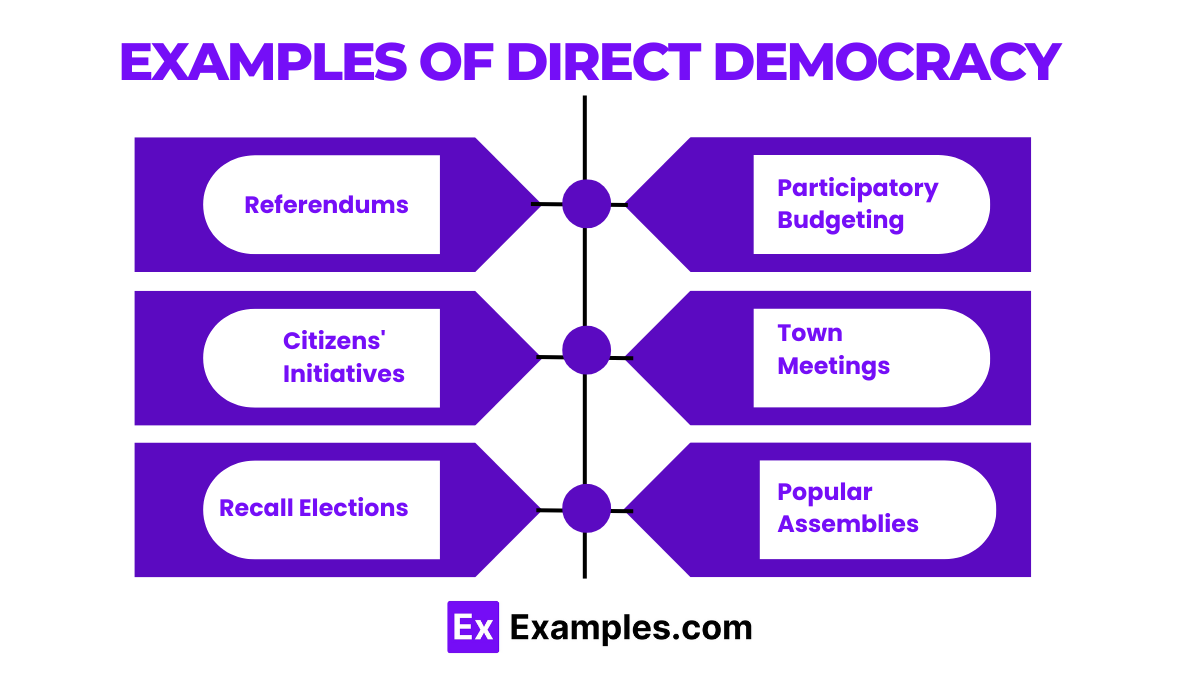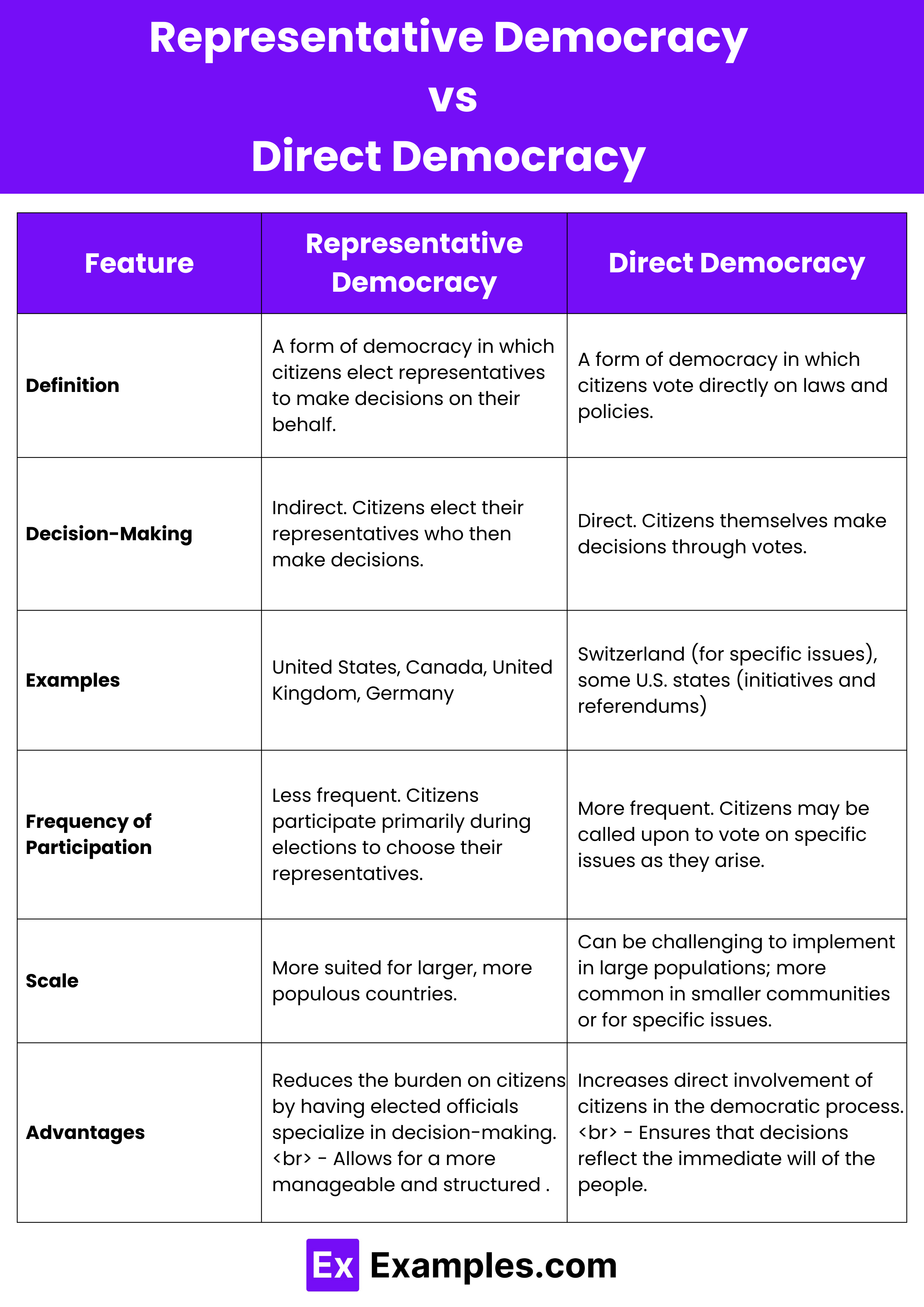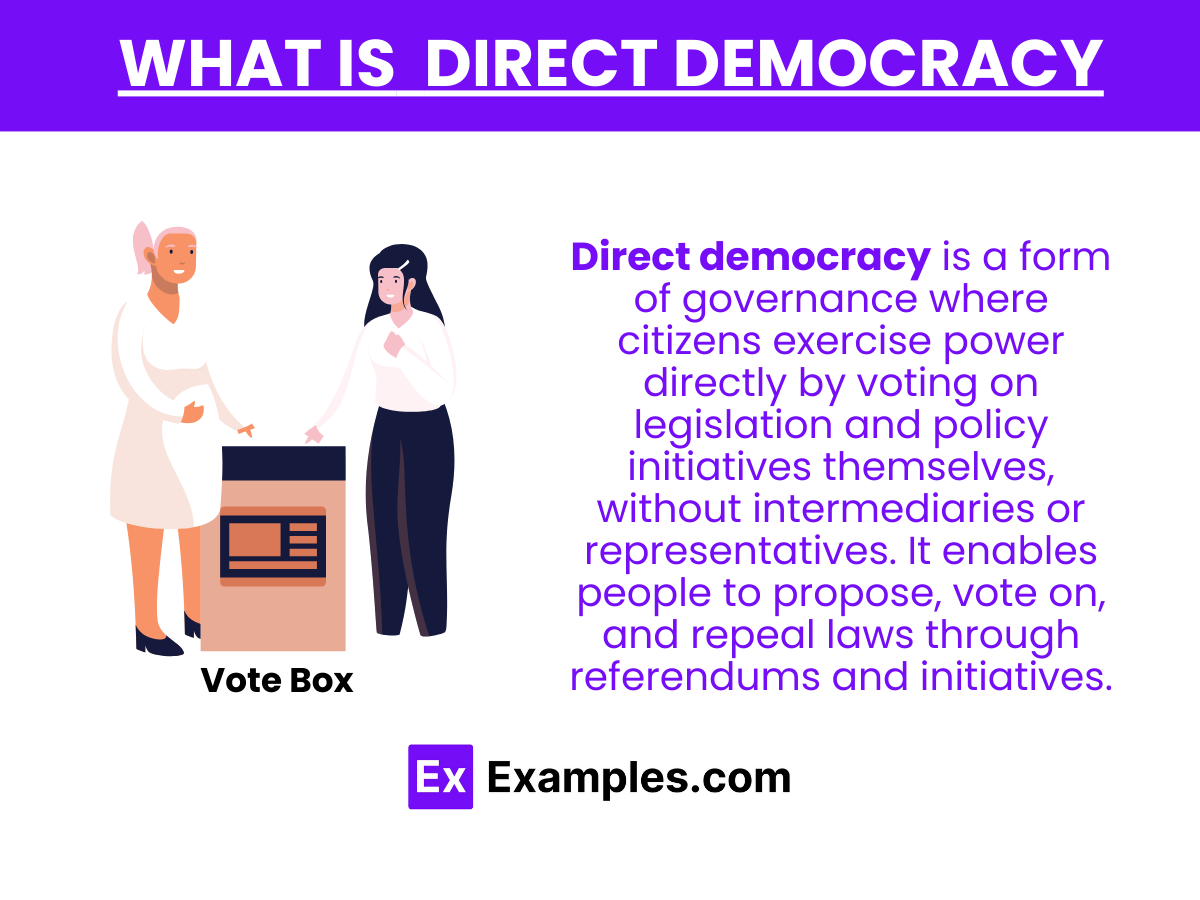Direct Democracy Examples
The world of Direct Democracy, where the voice of every citizen matters in the shaping of their governance. This comprehensive guide unveils the essence, mechanisms, and profound impact of Direct Democracy across history and in contemporary societies. From ancient Athens to modern-day referendums, explore how this pure form of democracy empowers citizens to directly participate in the legislative process, setting the foundations for a truly inclusive and participatory political system.
What is Direct Democracy ?
Direct democracy is a form of democracy in which people decide on policy initiatives directly, without intermediaries or representatives. It allows citizens to vote directly on laws and policies, rather than electing representatives to make those decisions on their behalf. This system can manifest through referendums, initiatives, and plebiscites, giving the electorate the power to propose, decide on, or repeal legislation and governmental policies. Direct democracy aims to give citizens a more active role in the legislative process, ensuring that their voices have a direct impact on governance.
History of Direct Democracy
The concept and practice of direct democracy trace back to ancient civilizations and have evolved over centuries, influencing various modern political systems. Here’s a comprehensive overview:
Ancient Origins
- Ancient Athens: Often considered the cradle of democracy, ancient Athens (5th century BCE) implemented a form of direct democracy where citizens could participate in decision-making assemblies to vote on laws and policies.
- Athenian Ecclesia: The Ecclesia, an assembly of Athenian citizens, was the principal body of direct governance, where any male citizen could speak and vote on legislative matters.
Medieval and Renaissance Developments
- Medieval Communes: In the Middle Ages, some European city-states and communes practiced forms of direct participation, although not democratic in the modern sense, contributing to the development of democratic ideas.
- Swiss Cantons: The Swiss Confederation, from its formation in the 13th century, adopted practices that resembled direct democracy, particularly in rural cantons where open assemblies, known as Landsgemeinden, allowed male citizens to vote on laws and policies.
Modern Era and Expansion
- American and French Revolutions: While these revolutions in the late 18th century established representative democracies, they also inspired debates about the role of direct participation in governance.
- 19th and 20th Century Movements: The expansion of democratic ideals in the 19th and 20th centuries saw the introduction of mechanisms like referendums and initiatives, allowing for direct democratic participation within largely representative systems.
20th Century to Present
- Adoption of Referendums and Initiatives: Many countries and states, especially in the 20th and 21st centuries, have incorporated referendums, initiatives, and plebiscites into their political processes, allowing citizens to vote directly on specific issues.
- Technological Advancements: The digital age has introduced new possibilities for direct democracy, with online platforms and e-voting making it easier for citizens to participate in decision-making processes.
- Contemporary Examples: Modern Switzerland stands out for its extensive use of direct democracy at both the federal and cantonal levels, including regular referendums. Similarly, some U.S. states extensively use ballot initiatives and referendums to decide on a range of issues.
Challenges and Criticisms
- Practical Limitations: Critics argue that direct democracy can be impractical in large, complex societies where not all citizens can be adequately informed about every issue.
- Majoritarian Concerns: There are concerns that direct democracy can lead to the “tyranny of the majority,” where the rights and needs of minorities may be overlooked.
Facts of Direct Democracy
Direct democracy is a fascinating and complex aspect of governance that empowers citizens to have a direct say in the legislative process. Here are key facts that highlight its features, applications, and impact:
Direct Participation
- Citizen Legislation: In direct democracy, citizens have the right to propose, vote on, and repeal laws directly, bypassing representative bodies.
- Referendums and Initiatives: These are common tools of direct democracy. Referendums allow citizens to vote on laws passed by the legislature, while initiatives enable them to propose laws or amendments for a public vote.
Historical Roots
- Ancient Athens: Often cited as the birthplace of democracy, Athens practiced a form of direct democracy where citizens could participate in decision-making assemblies.
Modern Examples
- Switzerland: Known for its modern application of direct democracy, Switzerland holds regular referendums at the national, cantonal, and municipal levels, allowing citizens to vote on a wide range of issues.
- U.S. States: Several states in the United States, like California and Oregon, utilize ballot initiatives and referendums, giving voters a direct voice in state governance.
Digital Evolution
- E-Democracy: Advances in technology have led to discussions and pilot projects around e-democracy, where digital platforms are used to facilitate direct participation in the legislative process.
Advantages
- Enhanced Accountability: Direct democracy mechanisms can hold elected officials more accountable, ensuring that laws and policies more accurately reflect the will of the people.
- Increased Political Engagement: The direct involvement in governance can lead to higher levels of political interest and engagement among citizens.
Challenges
- Complexity and Information Overload: The complexity of issues and the sheer volume of information can make it difficult for citizens to make informed decisions on every matter.
- Majoritarian Risks: There is a concern that direct democracy can lead to the tyranny of the majority, where the rights and interests of minority groups may be overridden by the majority vote.
Impact on Policy Making
- Responsive Legislation: Direct democracy can result in legislation that is more responsive to the immediate needs and desires of the populace.
- Policy Innovation: The ability for citizens to initiate legislation can lead to innovative solutions to social and political issues that might not emerge through representative bodies.
Examples of Direct Democracy

Direct democracy is a form of democracy in which people decide on policy initiatives directly, rather than through representatives in a legislative body. It enables citizens to vote on laws and policies directly, rather than having their elected officials make those decisions for them. Below are some key examples and mechanisms of direct democracy, explained through points and organized under headings.
1. Referendums
Referendums are one of the most common forms of direct democracy. They involve asking the entire electorate to vote on a specific proposal. This can range from constitutional amendments, changes to the law, or even the secession of a region from a country.
- Example: In 2016, the United Kingdom held a referendum to determine whether it should remain in the European Union. The result was a majority vote to leave, leading to the political process known as Brexit.
2. Citizens’ Initiatives
Citizens’ initiatives allow citizens to bypass the legislative body by placing new legislation or amendments directly on the ballot, as long as they can gather a required number of signatures from the electorate.
- Example: In Switzerland, citizens can propose changes to the constitution (federal initiatives) if they gather 100,000 signatures within 18 months. If successful, the proposal is put to a national vote.
3. Recall Elections
Recall elections allow voters to remove elected officials from office before their term is completed. A petition must gather a certain number of signatures to trigger a recall election.
- Example: In 2003, California held a recall election in which Governor Gray Davis was removed from office and replaced by Arnold Schwarzenegger.
4. Participatory Budgeting
Participatory budgeting is a process in which citizens are directly involved in the allocation and distribution of a portion of the municipal or public budget. Citizens have the power to decide how to spend part of the budget through voting.
- Example: The city of Porto Alegre in Brazil has been using participatory budgeting since 1989, allowing residents to decide on expenditures in areas such as infrastructure and social services.
5. Town Meetings
Town meetings are a form of direct democratic rule used primarily in parts of the United States. During these meetings, members of a community come together to legislate policy and budgets for local government.
- Example: In New England, town meetings are a common practice where residents of towns meet annually to approve the town budget, elect officers, and discuss other civic issues.
6. Popular Assemblies
Popular assemblies or people’s assemblies are gatherings where citizens come together to discuss and make decisions on public policies or issues affecting their community or nation.
- Example: In ancient Athens, the assembly (Ekklesia) was the principal organ of direct democracy, where citizens had the right to speak and vote on legislation.
Representative Democracy and Direct Democracy

| Feature | Representative Democracy | Direct Democracy |
|---|---|---|
| Definition | A form of democracy in which citizens elect representatives to make decisions on their behalf. | A form of democracy in which citizens vote directly on laws and policies. |
| Decision-Making | Indirect. Citizens elect their representatives who then make decisions. | Direct. Citizens themselves make decisions through votes. |
| Examples | United States, Canada, United Kingdom, Germany | Switzerland (for specific issues), some U.S. states (initiatives and referendums) |
| Frequency of Participation | Less frequent. Citizens participate primarily during elections to choose their representatives. | More frequent. Citizens may be called upon to vote on specific issues as they arise. |
| Scale | More suited for larger, more populous countries. | Can be challenging to implement in large populations; more common in smaller communities or for specific issues. |
| Advantages | – Reduces the burden on citizens by having elected officials specialize in decision-making. <br> – Allows for a more manageable and structured legislative process. | – Increases direct involvement of citizens in the democratic process. <br> – Ensures that decisions reflect the immediate will of the people. |
| Disadvantages | – Potential for elected representatives to not fully reflect the will of their constituents. <br> – May lead to a disconnect between citizens and the decision-making process. | – Requires a high level of public participation and awareness. <br> – Can lead to decision-making being influenced by short-term emotions rather than long-term considerations. |
FAQ of Direct Democracy
What is Direct Democracy?
Direct democracy allows citizens to vote directly on laws and policies, ensuring decisions reflect the public’s immediate will.
How Does Direct Democracy Work?
In direct democracy, citizens participate in decision-making by voting on laws and policies in referendums and initiatives.
Benefits of Direct Democracy
Direct democracy increases civic engagement and ensures policies align closely with the public’s preferences.
Challenges of Direct Democracy
Implementing direct democracy can be complex, requiring high public participation and a well-informed electorate.
Examples of Direct Democracy
Switzerland uses direct democracy for national decisions, and U.S. states utilize initiatives and referendums for local governance.
Direct democracy empowers citizens, fostering greater engagement in the political process and ensuring policies align with public will. While its implementation poses challenges, including high demands for participation and informed decision-making, the benefits of increased civic involvement and democratic accountability are undeniable. By adopting direct democracy practices, societies can enhance transparency and strengthen the connection between governments and their constituents.


